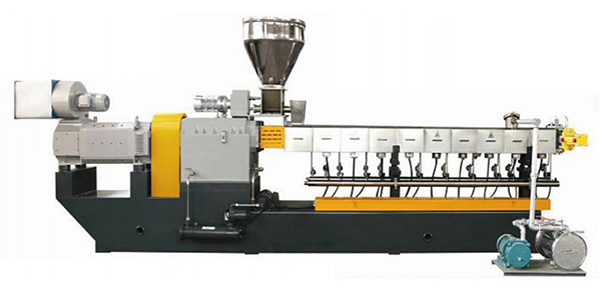Copyright © Shanghai Omega Machinery Co., Ltd. All rights reserved.
Twin screw extruder working principle
Jul 13,2023
Stage 1: Feeding the Materials
The journey begins with the introduction of raw materials into the extruder's hopper. As gravity guides the ingredients down, the co-rotating screws pull them further into the barrel. With their closely intermeshing threads, the screws ensure a consistent flow of materials, eliminating any room for inefficiency.
As the raw materials progress along the barrel, they experience an extraordinary transformation. The screws rotate at a synchronized speed, creating a shearing effect that leads to intensive mixing. This dynamic mixing action ensures that the materials are blended thoroughly, guaranteeing homogeneity in the final product. To add another layer of brilliance, twin screw extruders can incorporate heating elements along the barrel. These heaters melt certain materials, enhancing the overall processing efficiency. The carefully controlled temperature within the extruder barrel opens doors to a world of possibilities in various industries, including plastics, food processing, and pharmaceuticals.
Stage 3: Shaping and Extrusion
Once the materials have been thoroughly mixed and heated, they enter the final stage of the extrusion process. At this point, the screws narrow down, exerting pressure on the materials and creating the desired shape. The combination of precise design and controlled pressure allows for consistent and accurate shaping, making twin screw extruders an essential tool for creating complex structures with unparalleled precision.
Prev News Next News
- Information
- Why do the surfaces of extruded profiles have weld marks when extruding? What are the solutions to eliminate these marks?
- Why do large, dull and unreflective bubbles appear on the surface of the special profiles? How can this problem be solved?
- What causes the uneven surface and poor gloss of the sheet during the sheet extrusion process? How can it be solved?
- Why does the cooling process for profile extrusion become unbalanced?
- What countermeasures can be taken to improve the dimensional and positional accuracy of profiles during the profile production process?
- How should profile molds be cleaned and maintained?
- What are the corresponding solutions to the phenomenon of grooves and pits on the surface of profiles?
- How should the raw materials be selected in the formula for PVC surface skin core layer microcellular foamed extruded profiles?
- How should the production process of biaxially oriented polyethylene terephthalate (BOPET) film be controlled?
- How should the longitudinal and transverse stretching be controlled when producing biaxially oriented films by the flat film method?
- Contact Us

-
Shanghai Omega Machinery Co., Ltd.
Add.: No.168 Hualian Road, Putuo District, Shanghai City
Contact: Nina
Tel.: +86-021-69921527
Mobile: +86-15021464410
Fax: +86-021-69921567
E-mail: omegajessica@163.com;965425705@qq.com
WeChat No.: 1131449532
Whatsapp: +86 159 0054 6558

-
